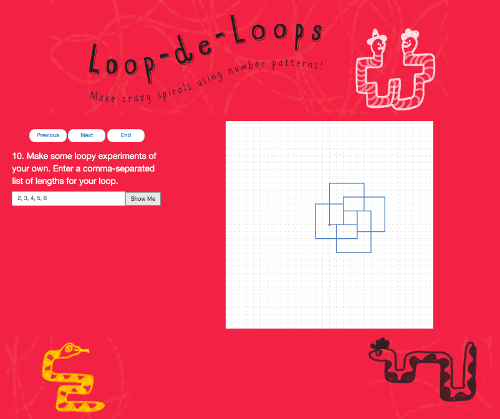~ Loops ~
Last week Dan Meyer announced a contest built around a loopy task from Anna Weltman in her new non-math math book, This is not a Math Book.
I turned the task into an interactive walkthrough and loop laboratory, which you’re cordially invited to use as a demonstration for your students in conjunction with Anna’s book (Dan excerpted a few pages here and here). Or, of course, if you just want to get nerd-sniped into messing around with loops for a little while.
Below I included a couple of problem sets I think would make for interesting extensions.

§ Faces and Vertices and Edges (Oh, my!)
-
(1) We saw that sometimes a loop only intersects itself at individual points (like the 2-3-4), while other times a loop will retrace a portion of itself (like the 3-5-2). Let’s call loops that retrace themselves clingy. Under what circumstances will a loop be clingy?
-
(2) A loop divides the plane into a bunch of regions that are walled off from the rest of the plane. Let’s call those regions cells. How many cells does the 2-1-4 loop have? (Hint: Don’t forget the big, huge, giant cell that’s outside the whole loop.)
-
(3) Each time a loop intersects itself at a point, it forms a little cross. How many crosses does the 2-1-4 loop have?
-
(4) If you start at a cross and trace your way along the loop, eventually you’ll either end up at another cross, or back at the same cross from a new direction. That portion of the loop between two crosses (or between a cross and itself) is called a blip. How many blips does the 2-1-4 loop have?
-
(5) Make a whole bunch of non-clingy loops. Can you find a relationship among the number of cells, crosses, and blips that a loop has?
-
(6) Find yourself a cube. How many faces does it have? How many vertices? How many edges?
-
(7) Find yourself a tetrahedron (admittedly a little bit harder). How many faces, vertices, and edges does it have?
-
(8) Get your hands on a bunch of convex polyhedra. (Unless you have some really nerdy math friends, you’re probably going to have to hit up the internet for this one). Can you find a relationship among the number of faces, vertices, and edges each one has?
-
(9) Convince yourself that this connection between loop-de-loops and convex polyhedra isn’t an accident.
§ Loops Gone Wild
-
(1) We looked at some loops with three lengths (3-loops), a loop with four lengths (a 4-loop), and a loop with five lengths (a 5-loop). The 3-loops all returned to their starting point, so let’s call them tame. (The 5-loop was also tame.) But the 4-loop spun off to infinity. Let’s call loops like that wild. Are there any wild 3-loops? Prove there aren’t or find a counterexample.
-
(2) Are there any tame 4-loops? If so, are there any that a snooty mathematician wouldn’t call trivial? Why or why not?
-
(3) For what n are n-loops guaranteed to be tame? Guaranteed to be wild? Neither necessarily tame nor necessarily wild?
-
(4) Let’s say that, instead of always changing direction in a counterclockwise way, at each step you pick a random direction (up, down, left, or right) in which to draw your line. Let’s call this new kind of loop a drunken loop. Are drunken 3-loops more likely to be wild then their sober counterparts? Are drunken 4-loops more likely to be tame?
-
(5) Remarkably (to me, at least), any drunken 1-loop (like 1-1-1-… or 9-…) is tame. Prove that there are no wild drunken 1-loops.
-
(6) Instead of restricting our loops to a 2D grid, let’s have them live in a 3D lattice. Now a drunken loop can head off, at each step, in one of 6 random directions in 3-space. Are all drunken 1-loops still tame? If not, what’s the probability a drunken 1-loop will be tame?
-
(7) As n increases, what happens to the probabilty that a drunken 1-loop is tame in Rn? Come up with a formula for that probability in terms of n.
